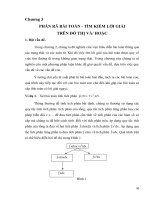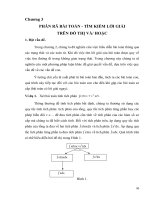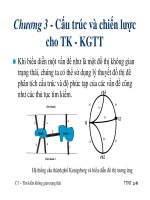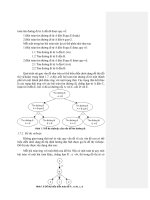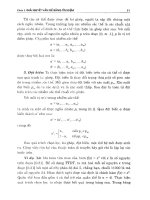Slide trí tuệ nhân tạo chapter7 3 structured knowledge
Bạn đang xem bản rút gọn của tài liệu. Xem và tải ngay bản đầy đủ của tài liệu tại đây (340.71 KB, 42 trang )
Structured Knowledge
Chapter 7
Logic Notations
Does logic represent well knowledge in structures?
2
Logic Notations
Frege’s Begriffsschrift (concept writing) - 1879:
assert P
P
not P
P
if P then Q
Q
P
for every x, P(x)
x
P(x)
3
Logic Notations
Frege’s Begriffsschrift (concept writing) - 1879:
“Every ball is red”
x
red(x)
ball(x)
“Some ball is red”
x
red(x)
ball(x)
4
Logic Notations
Algebraic notation - Peirce, 1883:
Universal quantifier: xPx
Existential quantifier: xPx
5
Logic Notations
Algebraic notation - Peirce, 1883:
“Every ball is red”: x(ballx —< redx)
“Some ball is red”: x(ballx • redx)
6
Logic Notations
Peano’s and later notation:
“Every ball is red”: (x)(ball(x) red(x))
“Some ball is red”: (x)(ball(x) red(x))
7
Logic Notations
Existential graphs - Peirce, 1897:
Existential quantifier: a link structure of bars, called line of
identity, represents
Conjunction: the juxtaposition of two graphs represents
Negation: an oval enclosure represents ~
8
Logic Notations
“If a farmer owns a donkey, then he beats it”:
farmer
owns
donkey
beats
9
Logic Notations
EG’s rules of inferences:
Erasure: in a positive context, any graph may be erased.
Insertion: in a negative context, any graph may be inserted.
Iteration: a copy of a graph may be written in the same
context or any nested context.
Deiteration: any graph may be erased if a copy of its occurs
in the same context or a containing context.
Double negation: two negations with nothing between them
may be erased or inserted.
10
Existential Graphs
Prove: ((p r) (q s)) ((p q) (r s)) is valid
11
Existential Graphs
Prove: ((p r) (q s)) ((p q) (r s)) is valid
p r
p q
q s
r s
12
Existential Graphs
Prove: ((p r) (q s)) ((p q) (r s))
Erasure: in a positive context,
any graph may be erased.
Insertion: in a negative context,
any graph may be inserted.
Iteration: a copy of a graph may
be written in the same context or
any nested context.
Deiteration: any graph may be
erased if a copy of its occurs in
the same context or a containing
context.
Double negation: two negations
with nothing between them may
be erased or inserted.
13
Existential Graphs
Prove: ((p r) (q s)) ((p q) (r s))
Erasure: in a positive context,
any graph may be erased.
Insertion: in a negative context,
any graph may be inserted.
Iteration: a copy of a graph may
be written in the same context or
any nested context.
Deiteration: any graph may be
erased if a copy of its occurs in
the same context or a containing
context.
p r
q s
Double negation: two negations
with nothing between them may
be erased or inserted.
14
Existential Graphs
Prove: ((p r) (q s)) ((p q) (r s))
Erasure: in a positive context,
any graph may be erased.
p r
q s
Insertion: in a negative context,
any graph may be inserted.
Iteration: a copy of a graph may
be written in the same context or
any nested context.
Deiteration: any graph may be
erased if a copy of its occurs in
the same context or a containing
context.
Double negation: two negations
with nothing between them may
be erased or inserted.
p r
q s
p r
15
Existential Graphs
Prove: ((p r) (q s)) ((p q) (r s))
Erasure: in a positive context,
any graph may be erased.
Insertion: in a negative context,
any graph may be inserted.
Iteration: a copy of a graph may
be written in the same context or
any nested context.
Deiteration: any graph may be
erased if a copy of its occurs in
the same context or a containing
context.
Double negation: two negations
with nothing between them may
be erased or inserted.
p r
q s
p r
p r
q s
p q r
16
Existential Graphs
Prove: ((p r) (q s)) ((p q) (r s))
Erasure: in a positive context,
any graph may be erased.
Insertion: in a negative context,
any graph may be inserted.
Iteration: a copy of a graph may
be written in the same context or
any nested context.
p r
q s
p q r
Deiteration: any graph may be
erased if a copy of its occurs in
the same context or a containing
context.
p r
Double negation: two negations
with nothing between them may
be erased or inserted.
pq
q s
r q s
17
Existential Graphs
Prove: ((p r) (q s)) ((p q) (r s))
Erasure: in a positive context,
any graph may be erased.
Insertion: in a negative context,
any graph may be inserted.
Iteration: a copy of a graph may
be written in the same context or
any nested context.
Deiteration: any graph may be
erased if a copy of its occurs in
the same context or a containing
context.
Double negation: two negations
with nothing between them may
be erased or inserted.
p r
pq
q s
r q s
p r
p q
q s
r s
18
Existential Graphs
Prove: ((p r) (q s)) ((p q) (r s))
p r
p r
q s
q s
p r
p r
q s
p r
p q
q s
p r
q s
r s
pq
r q s
p q r
19
Existential Graphs
•
a-graphs: propositional logic
•
b-graphs: first-order logic
•
-graphs: high-order and modal logic
20
Semantic Nets
• Since the late 1950s dozens of different versions of
semantic networks have been proposed, with various
terminologies and notations.
• The main ideas:
For representing knowledge in structures
The meaning of a concept comes from the ways it is
connected to other concepts
Labelled nodes representing concepts are connected by
labelled arcs representing relations
21
Semantic Nets
Mammal
Is a
Person
White
uniform
color
has-part
Nose
instance
Kaka
team
Real
person(Kaka) instance(Kaka, Person)
team(Kaka, Real)
22
Semantic Nets
John
Bill
height
H1
height
greater-than
H2
value
1.80
23
Semantic Nets
“John gives Mary a book”
Give
John
agent
g
instance
object
Book
instance
b
beneficiary
give(John, Mary, book)
Mary
24
Frames
• A vague paradigm - to organize knowledge in highlevel structures
• “A Framework for Representing Knowledge” - Minsky,
1974
• Knowledge is encoded in packets, called frames
(single frames in a film)
Frame name + slots
25

